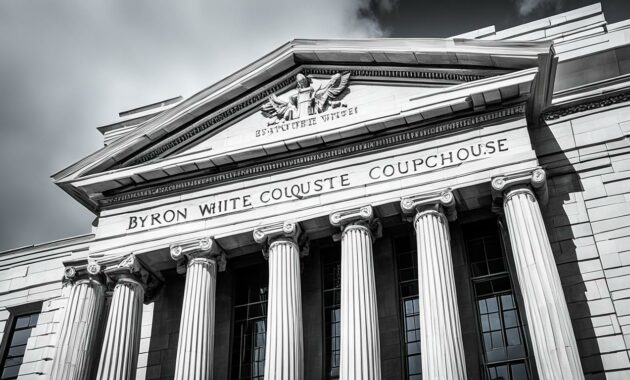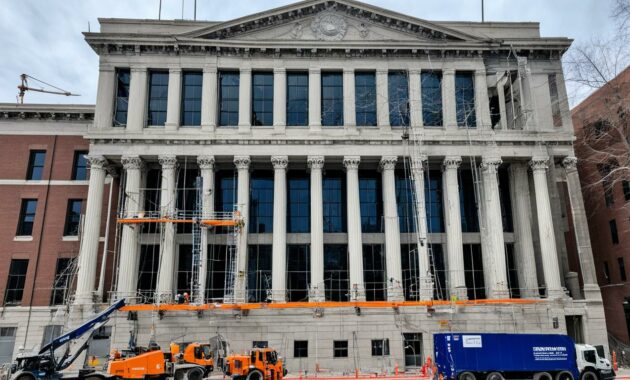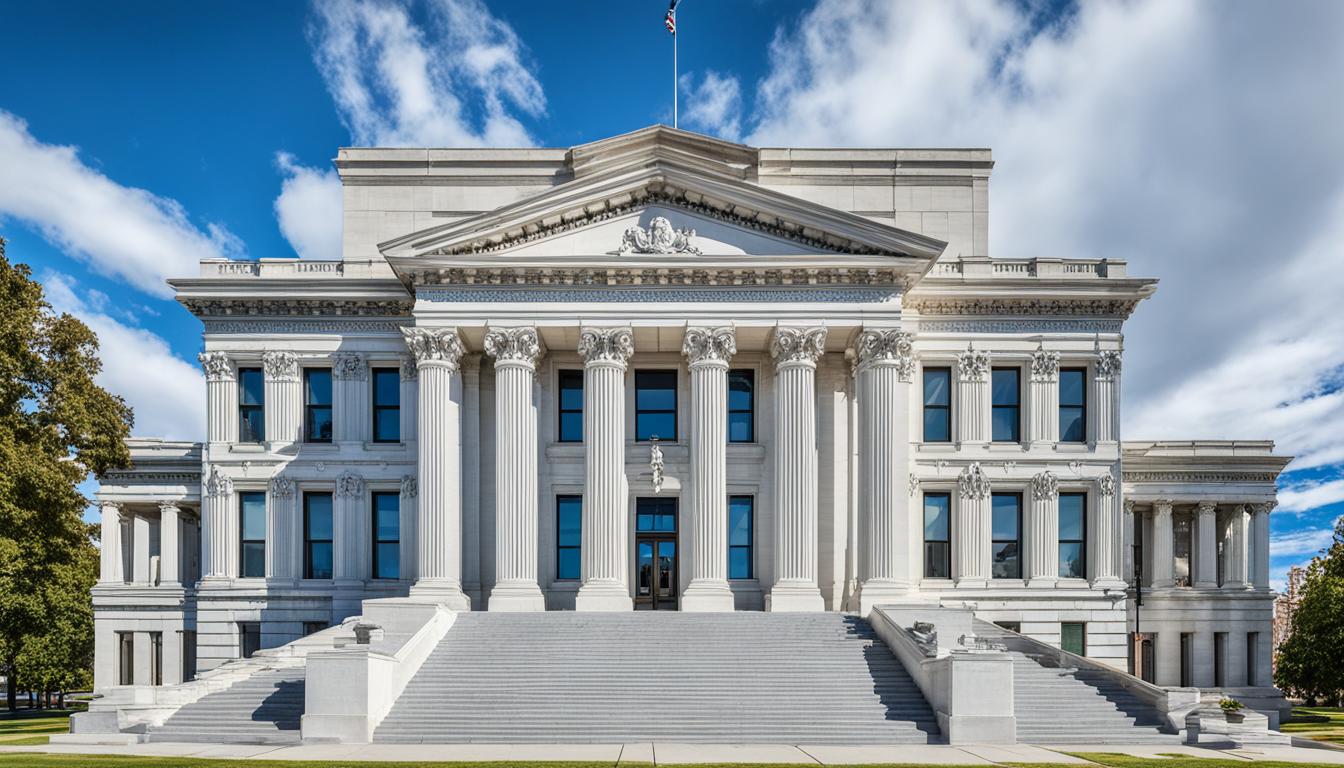Situated in downtown Denver, the Byron R. White U.S. Courthouse is a monument. It shows off the city’s rich past in architecture. This neoclassical building was created by Tracy, Swartwout, and Litchfield. It started working in 1916, offering post office services and as a federal courthouse.
The courthouse is grand and full of elegant features. It has always been key to Denver’s history and is much loved.
Neoclassical Gem in the Heart of Downtown Denver
The Byron White Courthouse shines brightly with neoclassical charm. This design was very popular for federal buildings in the early 1900s. Made from Colorado Yule marble, the same as the Lincoln Memorial, the building shows off a large three-story portico. It has sixteen big ionic columns with American eagles on top. The sides of the building also have ionic columns, adding even more to its grand neoclassical style.
Imposing Exterior with Ionic Columns and Yule Marble
Approaching the Byron White Courthouse, guests see its impressive neoclassical architecture denver. The yule marble denver on the outside shines in the sun. It gives a feeling of timeless beauty, perfect for a place of justice.
Grand Interior Spaces with Vaulted Ceilings and Ornate Details
Walk inside the courthouse to find a wide, grand lobby. Its ceiling is vaulted, with arches and pilasters that make you look up in awe. The details and craft inside show that this is a place for important work and everyone.
“The Byron White Courthouse is a true architectural masterpiece. It mixes neoclassical grace with Denver’s best workmanship.”
A Storied History Dating Back to the Early 20th Century
The Byron White Courthouse is in Denver and dates back to the early 1900s. It was picked to be designed by a famous team in 1909. This team was known for their work on government buildings.
Work started in 1910, but money troubles slowed things down. Denver’s postmaster helped get more money, and the building opened in 1916. It was a big deal for everyone.
Designed by Renowned Architects Tracy, Swartwout, and Litchfield
The architects Tracy, Swartwout, and Litchfield are well-known. They worked on many key buildings in the U.S. Their design for the Denver courthouse is a great example of their skill.
It has large columns and uses a special marble from Colorado. This marble is also on the Lincoln Memorial and the Tomb of the Unknown Soldier.
Construction Challenges and Delays, but a Triumphant Opening in 1916
Building the courthouse had its problems. At first, they didn’t have enough money. Later, they got more money to finish the job.
After six years, the courthouse finally opened in 1916. This was a happy moment for the city of Denver.
| Fact | Value |
|---|---|
| Construction Start | 1910 |
| Construction Completion | 1916 |
| Original Cost | $1,900,000.00 |
| Building Material | Colorado Yule Marble |
| National Register of Historic Places | 1973 |
| Renaming in Honor of Justice White | 1994 |
“The Byron White Courthouse in Denver is built with Colorado Yule marble, the same material used for the exterior of the Lincoln Memorial and the Tomb of the Unknown Soldier in Washington D.C”
Byron white courthouse: Denver’s Monumental Federal Building
The Byron White Courthouse in Denver, Colorado, stands out as a big attraction. It’s at the heart of the city and shows the style of Neoclassical architecture. This means it has symmetrical designs, details from ancient Greece and Rome, and looks impressive.
It was finished between 1910 and 1916, originally expected to cost $1,500,000. But it ended up costing about $2,586,000. Even though it faced money and time problems, its beauty and size still make Denver proud.
The front has 16 huge columns, making it one of the tallest buildings at the time. It was seen as the most stunning building to the west of the Mississippi River. Because of its importance, it has been on the National Register of Historic Places since 1973.
| Key Facts | Details |
|---|---|
| Original Budget | $1,500,000, later increased to $1,900,000 |
| Final Cost | Approximately $2,586,000 |
| Occupancy | U.S. District Court, U.S. Court of Appeals, Post Office, and various federal offices |
| Architectural Significance | Considered the most beautiful building west of the Mississippi River |
| National Register of Historic Places | Listed since 1973 |
The courthouse is a symbol of Denver’s progress and the strong U.S. presence in the West. This grand federal building is a key part of Denver’s story. It shows off the city’s pride and history.

Architectural and Artistic Masterpieces Within
The Byron White Courthouse in Denver is a historic gem. It is filled with stunning art and architecture. This includes canvas murals by Herman Schladermundt and limestone sculptures by Gladys Caldwell Fisher.
Schladermundt’s Iconic Canvas Murals
In 1918, Schladermundt’s paintings were put in the main lobby. They show the area as a hub for government and business. His pieces like “Fortune Turns on Her Wheel — The Fate of Kings” and “Postal Service” are full of bright colors and fine details. They make you feel like you’re in the early 1900s.
Gladys Caldwell Fisher’s Sculptures
Gladys Caldwell Fisher made limestone statues of Rocky Mountain sheep in 1936. They stand at the southwest entrance. These sculptures mix the courthouse’s grand architecture with Denver’s natural beauty. They add to the building’s cultural value.
“The artworks within the Byron White Courthouse are a testament to Denver’s enduring commitment to preserving its cultural and architectural treasures. These masterpieces not only captivate visitors but also serve as a source of civic pride for the community.”
Renovations and Restorations: Preserving a Denver Treasure
The Byron White Courthouse in Denver is a landmark that has seen lots of changes. Each change was meant to keep its old charm and use. The 1950s and 1960s brought major changes, like the U.S. Postal Service’s updates and even taking some parts down.
Meticulous 1990s Restoration to Original Grandeur
In the 1990s, though, a huge project started to bring it back. This effort focused on the building’s use as the Tenth Circuit Court of Appeals. They made it look like before by fixing the Appellate Courtroom and Grand Jury Room. The lobby, courtrooms, and other spots were also redone to look as stunning as they did at first.
The 1990s restoration required a lot of care and knowing the building’s story. The team put a lot of effort to honor the original plan. Their work brought the Byron White Courthouse back to its full beauty.
| Renovation Period | Key Alterations | Restoration Efforts |
|---|---|---|
| 1950s and 1960s |
|
N/A |
| 1990s | N/A |
|
The 1990s fix of the Byron White Courthouse was key to keeping it for the next generations. By undoing the 20th-century updates, the team showed the building’s true beauty. This made sure the courthouse still tells Denver’s story and how it values history.

Honoring Justice Byron R. White: A Colorado Native Son
In 1994, the Byron R. White U.S. Courthouse took its name in Denver. This was done to honor a Colorado native who was a Supreme Court Justice from 1962 to 1993. Justice Byron White was born in Fort Collins. He was well-known for being both a scholar and an athlete.
He is known for his approach to the law and his dedication to it. His work as a Supreme Court Justice has had a lasting impact. The renaming of the Denver courthouse recognizes this record and his service to the nation.
Justice White was picked for the Supreme Court by President Kennedy in 1962. He wrote almost 1,000 opinions over his time there. His work and his path in life show the importance of working hard and not giving up.
He was the top student at the University of Colorado. He did well in sports and was even a Rhodes Scholar. Before his work in law, he played professional football. He is remembered as a key figure in the legal world. His achievements continue to be an inspiration in Denver and across Colorado.

